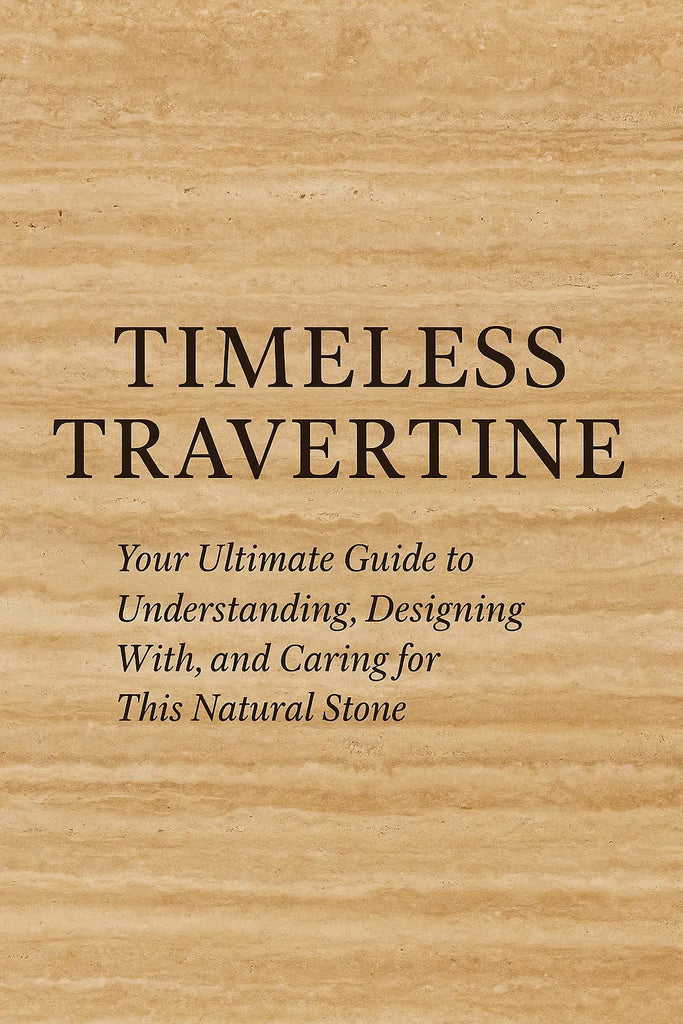Timeless Travertine: Your Ultimate Guide to Understanding, Designing With, and Caring for This Natural Stone

Timeless Travertine: Your Ultimate Guide to Understanding, Designing With, and Caring for This Natural Stone
Part 1: Understanding Travertine – Nature's Earthy Masterpiece
1.1 Introduction: The Enduring Appeal of Travertine
In the vast and varied world of natural stone, travertine stands out as a material of profound historical significance and enduring aesthetic appeal. Often celebrated for its unique blend of rustic charm and understated elegance, travertine has graced structures from the Colosseum in Rome to modern architectural marvels, consistently delivering a sense of warmth, authenticity, and grounded sophistication. Its distinctive porous texture and earthy color palette evoke the very essence of nature, bringing a timeless, organic beauty to any space.
At Surfaces Galore, located right here in Anaheim, California, we cherish travertine for its versatile beauty and incredible durability. We are dedicated to providing our clients in Orange County and beyond with the highest quality travertine products, helping them infuse their homes and commercial spaces with its inviting character. But what exactly is travertine, and what makes it so special?
This comprehensive guide is meticulously crafted to be your definitive resource for everything travertine. Whether you're contemplating travertine for a cozy outdoor patio, a serene bathroom floor, a striking kitchen backsplash, or elegant interior tiling, we'll journey through every critical aspect. From its fascinating geological formation near ancient hot springs, to understanding its diverse finishes and types, incorporating it into the latest design trends of 2025, and ensuring its unique beauty lasts for generations through proper care and maintenance, this guide covers it all. By the end, you’ll possess the knowledge to confidently choose, design with, and cherish your travertine for years to come.
1.2 What is Travertine? A Journey from Thermal Springs to Your Home
Travertine is a natural wonder, a form of terrestrial limestone created through a geological process deeply connected to specific geothermal environments. Unlike marble, which forms under intense heat and pressure deep within the Earth, travertine is a sedimentary rock formed at or near the Earth's surface, particularly around hot springs and geysers. Its unique formation process is what gives it its characteristic appearance and properties.
1.2.1 The Unique Formation of Travertine: A Dance with Hot Springs and Minerals
Travertine's story begins as groundwater, superheated by geothermal activity, rises to the surface. As this mineral-rich water emerges from hot springs, geysers, or subterranean streams, it is saturated with dissolved minerals, primarily calcium carbonate (CaCO3). When this water reaches the cooler, lower-pressure environment of the surface, it rapidly degasses, releasing carbon dioxide. This release of CO2 causes the calcium carbonate to precipitate out of the water, forming layers of solid rock.
This precipitation process often incorporates organic matter, such as plants, algae, and mosses, which become trapped within the accumulating calcium carbonate layers. As this organic material decays, it leaves behind the distinctive pitting and voids that are characteristic of travertine. These natural pores are a defining feature of the stone and are often filled with grout or resin during processing for various applications.
The rate of deposition, the purity of the water, and the presence of other minerals influence the travertine's final appearance, including its porosity, hardness, and color. The constant flow of mineral-rich water results in the layered, often banded appearance that is typical of many travertine formations. This process can be remarkably fast on a geological timescale, with travertine accumulating much more quickly than other sedimentary rocks like limestone.
1.2.2 Key Characteristics & Properties of Travertine: Beyond Its Beauty
Understanding travertine's inherent characteristics is vital for appreciating its beauty and for making informed decisions about its use.
- Porous Nature: As mentioned, travertine is naturally porous due to the trapped organic matter and gas bubbles during its formation. This porosity gives it excellent slip resistance but also means it must be sealed to prevent staining and water absorption, especially for indoor applications like flooring and countertops.
- Earthy Color Palette: Travertine typically comes in a warm, inviting range of colors, including creams, beiges, tans, browns, golds, rusts, and occasionally reds or silvers. These colors are derived from iron oxides and other minerals present during its formation. Pure travertine is often a creamy white.
- Unique Surface Texture: Even when filled and honed, travertine retains a subtle, organic texture that contributes to its natural feel. Different finishes can greatly enhance or smooth out this texture.
- Durability: Travertine is a relatively durable stone, commonly used in high-traffic areas for millennia. While softer than granite or quartz, it is strong enough for most residential and many commercial applications. It develops a beautiful patina over time, adding to its character.
- Thermal Conductivity: Like many natural stones, travertine can conduct and retain heat, making it an excellent choice for radiant floor heating systems. Conversely, its cool surface is pleasant in warm climates.
- Reaction to Acids (Etching): Similar to marble, travertine is primarily composed of calcium carbonate, making it susceptible to etching from acidic substances (lemon juice, vinegar, certain cleaning products). These acids react with the calcium carbonate, dulling the surface. This is particularly noticeable on polished finishes but less so on honed or tumbled surfaces.
1.2.3 Travertine vs. Marble: Choosing the Right Natural Stone for Your Project
While both travertine and marble are forms of natural stone and are popular choices for luxurious interiors, they have distinct geological origins, physical properties, and aesthetic qualities. Understanding these differences is crucial when deciding which material is best suited for your specific project.
1.3 Global Travertine Quarries: Where Natural Beauty is Unveiled
Travertine is quarried in various locations around the world, each geological site imbuing the stone with unique colors, patterns, and characteristics. The origin of the travertine often speaks to its distinct aesthetic and performance. At Surfaces Galore, we meticulously source our travertine products from reputable quarries to ensure you receive the finest natural stone available.
1.3.1 Italian Travertine: The Roman Legacy
Italy, particularly the region of Tivoli near Rome, boasts the most historically significant travertine quarries. The Romans extensively used travertine for their iconic structures like the Colosseum and St. Peter's Basilica, a testament to its enduring strength and beauty.
-
Roman Travertine (Travertino Romano): This classic Italian travertine typically features a light beige to walnut color, often with distinct bands and a relatively uniform texture. It's known for its robust nature and has been used for centuries in some of the world's most enduring architecture. It's often cut in two ways:
- Vein-cut (al verso): Cut parallel to the bedding planes, showcasing the long, continuous bands or veins of the stone.
- Cross-cut (al contro): Cut perpendicular to the bedding planes, revealing more of a cloudy, circular pattern and less distinct banding.
- Noce Travertine: A rich, dark brown Italian travertine, often with lighter cream or beige veins. Its deep, warm tones make it ideal for creating luxurious and inviting spaces.
- Classic Travertine: A broad category often referring to light beige to cream-colored travertine, widely exported for its versatility.
1.3.2 Turkish Travertine: Abundance and Versatility
Turkey has emerged as the world's largest exporter of travertine, with vast quarries primarily located in the Denizli region. Turkish travertine is highly valued for its abundant supply, consistent quality, and a wide array of colors and finishes, making it a popular choice for global markets.
- Denizli Travertine: This is the most common Turkish travertine, available in various shades of light beige, cream, and tan. It's known for its relatively consistent color and texture, making it versatile for large-scale projects.
- Classic Light Travertine: A very popular type, offering soft, consistent creamy beige tones that blend seamlessly with many design aesthetics.
- Cappadocia Travertine: Named after the unique region, this travertine can display a wider range of colors, including warmer golden tones, rusts, and even some reds.
- Silver Travertine: A striking variety with a greyish base interspersed with darker grey, silver, or even reddish-brown veins. It offers a more contemporary and dramatic alternative to traditional warm-toned travertine.
1.3.3 Other Notable Origins: A Global Spectrum
While Italy and Turkey are dominant, travertine is also quarried in several other countries, each offering unique variations:
- Mexico: Mexican travertine, particularly from the area around Tehuacán, Puebla, is known for its light beige and cream tones, often with a slightly more open and rustic texture.
- Peru: Peruvian travertine often features rich, warm colors, including reds, golds, and rusts, making it a distinctive choice.
- Iran: Iranian travertine comes in a variety of colors, from light cream to red and yellow, often with interesting banding patterns.
- United States: Limited commercial travertine quarries exist in the U.S., notably in places like Yellowstone National Park (where it's part of natural formations but not quarried for commercial use) and some smaller quarries in the Western states.
1.4 Ethical Sourcing & Sustainability in the Travertine Industry: Making Conscientious Choices
In an increasingly conscious market, the origin of your travertine—and the practices behind its extraction—are as important as its aesthetic qualities. At Surfaces Galore, we believe that the beauty of natural stone should also reflect responsible environmental stewardship and ethical labor practices.
- Environmental Responsibility: Sustainable quarrying practices for travertine focus on minimizing ecological impact. This includes careful land rehabilitation after quarrying, efficient water recycling to reduce consumption, and methods to reduce dust and noise pollution. Responsible quarries work to integrate their operations with the surrounding ecosystem.
- Resource Management: Travertine, like other natural stones, is a finite resource. Sustainable practices emphasize efficient cutting techniques to maximize yield from each block, minimizing waste during processing. Waste material is often recycled for aggregates or other construction purposes.
- Fair Labor Practices: Ethical sourcing ensures that travertine is extracted and processed under humane conditions, with fair wages, safe working environments, and respect for worker rights. This contrasts sharply with unregulated practices that can harm both people and the environment.
- Durability as Sustainability: Choosing a durable material like travertine is inherently a sustainable decision. Its exceptional longevity means it doesn't need frequent replacement, reducing waste and the energy associated with manufacturing new materials. A well-maintained travertine installation can last for centuries.
- Surfaces Galore's Commitment: We are committed to transparency in our supply chain. We prioritize forging strong, long-lasting partnerships with quarries and suppliers who adhere to robust environmental regulations and ethical labor standards. Our goal is to provide you with beautiful, high-quality travertine that you can feel good about installing in your home.
Understanding travertine's unique formation, its distinguishing characteristics, and its global origins allows for a deeper appreciation of this remarkable natural stone. This knowledge empowers you to make informed decisions that bring both beauty and conscientious choice to your design projects.

Leave a comment